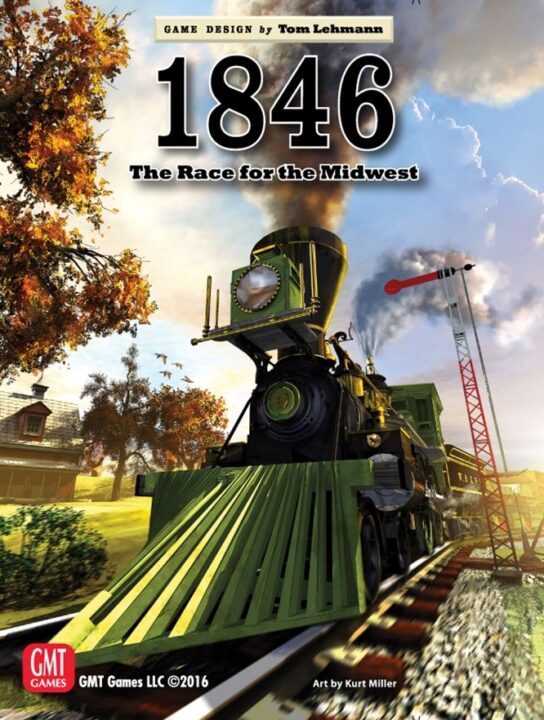How To Play: 1846: The Race for the Midwest – Setup, rule summary and strategy
Master 'How To Play 1846: The Race for the Midwest' with our comprehensive guide. We share insights on key strategies covering company selection, track laying, station placement, and stock manipulation to dominate the Midwest railway. Whether you’re auctioning, strategizing routes, or timing the market, our tips pave the track to victory.

Overview
Welcome to the comprehensive guide on ‘How To Play 1846: The Race for the Midwest’. In the paragraphs that follow, not only will we outline the basic rules of this intricate and competitive game, but we’ll delve into the top strategies that will enhance your chances of victory. Whether you’re new to 1846 or looking to sharpen your game, get ready to embark on a journey through the heart of the American Midwest railroading empire!
What’s in the box
- 1 Game Board
- 5 Company Charters
- 7 Private Company Certificates
- 40 Public Company Stock Shares
- 1 Priority Deal Card
- 6 Private Company Tokens
- 1 Bank Pool Token
- 60 Trains
- 1 Round Marker
- 1 Bank Market Marker
- 1 Starting Player Token
- 1 Rulebook
- Money in various denominations
- Track Tiles
- Station Tokens
How To Play 1846: The Race for the Midwest: Rules Summary
Setting Up the Game
- Unfold the game board centrally for all players.
- Distribute cash based on player count.
- Separate the company charters and matching tokens.
- Lay out the market and stock shares.
- Choose initial Private Companies via draft or auction.
Fundamentals of Gameplay
- Start with the Stock Round where players buy and sell shares.
- Transition into Operating Rounds, where corporations run trains for revenue.
- Companies lay tracks, place station tokens, and run train routes.
- Earnings are either paid out or retained for company growth.
- New Stock Rounds begin after Operating Rounds finish, and shares are further traded.
Crossing the Finish Line: Victory Conditions
- The game concludes after a set number of Stock Rounds or if the bank breaks.
- Tally final cash and share values for scoring.
- The highest total valuation wins the game.
Situational Rules and Exceptions
- Penalization for companies that can’t run a train.
- Requirements for track progression through certain hexes.
- Unique abilities of Private Companies and how they integrate with your strategy.
- Prohibition against owning above 60% of any corporation’s stock.
Best 1846 The Race For The Midwest Strategies
Mastering the Auction: Pathway to Victory in 1846
In ‘How To Play 1846: The Race for the Midwest,’ selecting the right companies can make or break your game start. Initially, evaluate the companies up for auction. Look for potential revenue and expansion opportunities tied to each company’s geographical position. Linking these to available private companies can boost your earnings out of the gate.
Assess Company Prospects
- Examine companies’ initial track layouts.
- Analyze expansion potential.
- Consider private company synergy.
Influence Auction Outcomes
Bidding strategically during the auction phase is paramount. Begin by setting a clear budget for how much you’re willing to invest. Moreover, don’t shy away from aggressively bidding on companies with synergistic bonuses, as early gains often lead to long-term advantages.
- Define your spending limit.
- Compete for prime companies.
- Bid up valuable assets.
Diversify Early Investments
Lastly, diversify your profile without overextending. This can also involve small but shrewd investments in companies you might later use solely to trade for more potent ones during the game. Remember, How To Play 1846: The Race for the Midwest is a delicate balance between aggressive growth and precautionary consolidation.
- Balance diversification with overextension.
- Use minor enterprises as leverage.
- Position for mid-game trades.
Mastering the Rails: Track Laying and Station Placement
Laying track and positioning stations are pivotal in How To Play 1846: The Race for the Midwest. Firstly, always be mindful of potential routes. They should maximize your revenue while possibly hindering others.
Strategic Expansion
- Focus on key hubs that offer diverse routing options, thus ensuring consistent income.
Blocking Strategies
- When possible, place stations to block competitors from lucrative areas.
Long-term Planning
- Anticipate where rivals may expand and secure important junctions beforehand.
Mastering the Share Shuffle: A Key to Victory
Folks, navigating the stock market in ‘How To Play 1846: The Race for the Midwest’ can be tricky, but it’s where champions emerge. Betting on startups can snowball you to wealth or tumble your empire. Let me share a tale: I gambled on a fledgling where others saw ruin, handsomely profiting! Active vigilance over share dominance sustains control. Now, for untangling this web;
- Prioritize companies with clear expansion routes – they churn revenue.
- Balance portfolio for risk mitigation—don’t overcommit to a sinking ship.
- Adopt a buy-low, sell-high rhythm; timing is critical.
Initial Investments
Diversifying Holdings
Market Timing
Mastering the Midwest: Final Thoughts
After diving deep into company selection, track strategies, and the ebb and flow of the stock market in 1846: The Race for the Midwest, you now hold the blueprint to vie for dominance over these iron rails. Like any well-oiled locomotive, your pathway to victory involves meticulously planning your moves, adapting to rival tactics, and ensuring your investments bear fruit. My game nights often buzz with excitement as each friend scrambles to outmaneuver the other. Seize these insights, gather your friends, and may the best railroad tycoon claim the Midwest crown!
Want to know what we think of 1846: The Race for the Midwest? Read our detailed review of 1846: The Race for the Midwest here

